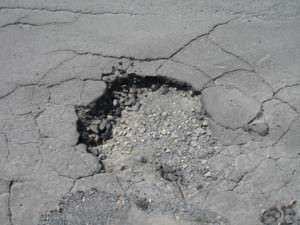Fleet Safety Tip: Dealing With Potholes
March 17, 2015
Snow-slick roads are a memory now, but drivers still have that old familiar post-winter foe to contend with Potholes
Potholes form when moisture collects in small holes and cracks in the road surface. The moisture expands and contracts when temperatures go up and down. This breaks up the pavement and, combined with the weight of passing cars, eventually results in a pothole; heavy spring rains have only added to this prolific problem. Driving through a pothole at a high speed increases the chances of damaging tires, wheels, shocks, or struts.
Because of this winter’s extreme freeze-and-thaw cycles in many areas, the spring of 2015 promises to deliver quite a pothole season. That’s good news for collision repair shops, dreadful news for fleet managers and drivers.
AAA recommends a number of measures to help prevent pothole damage. You may want to pass these AAA tips along to fleet drivers:
Inspect Tires
The tire is the most important cushion between a vehicle and a pothole. Make sure tires have enough tread and are properly inflated. When checking tire pressures, make sure they”re inflated to the manufacturer’s recommended levels, which can be found in the owner’s manual or on a sticker on the driver’s door jamb. Do not use the pressure levels stamped on the sidewall of the tire.
Inspect Suspension
Make certain struts and shock absorbers are in good condition. Changes in vehicle handling, excessive vibration or uneven tire wear can indicate bad shocks or struts. Have the suspension inspected by a certified technician if you suspect problem’s.
Look Ahead
When driving, make a point of checking the road ahead for potholes. An alert driver may have time to avoid potholes, so it’s important to stay focused on the road and not any distractions inside or outside the vehicle. Before swerving to avoid a pothole, check surrounding traffic to ensure this will not cause a collision or endanger nearby pedestrians or cyclists.
Slow Down
If a pothole cannot be avoided, reduce your speed safely. Make sure to check the rearview mirror before any abrupt braking. Hitting a pothole at higher speeds greatly increases the chance of damage to tires, wheels and suspension components.
Beware of Puddles
A puddle of water can disguise a deep pothole. Use care when driving through puddles and treat them as though they may be hiding potholes.
Check Alignment
Hitting a pothole can knock a vehicle’s wheels out of alignment and affect the steering. If your car or truck starts pulling to the left or right, have the wheel alignment checked by a qualified technician.
Recognize Noises or Vibrations
A hard pothole impact can dislodge wheel weights, damage a tire or wheel, and bend or even break suspension components. If you hit a pothole, listen for any new or unusual noises or vibrations. If you notice any, it’s time to have the vehicle checked by a technician.
Drivers are encouraged to report pothole locations on roads to their local county government, or to the state highway administration when potholes are noticed on state roads, which are numbered, non-toll roads.
Drive Safe!
Source: http://www.automotive-fleet.com/
Source: blog

